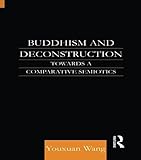Buddhism and Deconstruction : towards a comparative semiotics / Wang Youxuan.
Material type: TextPublication details: Hoboken : Routledge, Taylor and Francis, 2014.Description: 1 online resource (257 pages)Content type:
TextPublication details: Hoboken : Routledge, Taylor and Francis, 2014.Description: 1 online resource (257 pages)Content type: - 9781136845734
- 1136845739
- 1306580188
- 9781306580182
- Kumārajīva, -412?
- Xuanzang, 602-664
- Paramārtha, 499-569
- Derrida, Jacques, 1930-2004
- Derrida, Jacques
- Kumārajīva, -412?
- Paramārtha, 499-569
- Xuanzang, approximately 596-664
- Semiotics -- Religious aspects -- Buddhism
- Buddhism -- Doctrines
- Buddhism -- China -- History
- Deconstruction
- Critical theory
- Deconstructivism (Architecture)
- Bouddhisme -- Doctrines
- Bouddhisme -- Chine -- Histoire
- Déconstruction
- Théorie critique
- Déconstructivisme (Architecture)
- Deconstructivist
- critical theories (dialectical critiques)
- deconstruction (theory)
- critical theory (sociological concept)
- RELIGION -- Comparative Religion
- Semiotics -- Religious aspects -- Buddhism
- Buddhism
- Buddhism -- Doctrines
- Critical theory
- Deconstruction
- China
- 294.30951 22
- BQ7235
- online - EBSCO
| Item type | Current library | Call number | URL | Status | Notes | Barcode | |
|---|---|---|---|---|---|---|---|
 eBook
eBook
|
Biblioteca "Angelicum" Pont. Univ. S.Tommaso d'Aquino Nuvola online | online - EBSCO (Browse shelf(Opens below)) | Online access | Not for loan (Accesso limitato) | Accesso per gli utenti autorizzati / Access for authorized users | (ebsco)756185 |
Browsing Biblioteca "Angelicum" Pont. Univ. S.Tommaso d'Aquino shelves, Shelving location: Nuvola online Close shelf browser (Hides shelf browser)
Print version record.
Cover; Half Title; Title Page; Copyright Page; Dedication; Table of Contents; Foreword ; Preface; Introduction: The pursuit of signs; 1. Three grades of understanding in the Hīnayāna analytic system: A structural study of the list of seventy-five factors; 2. Undoing the Hīnayāna Onto-epistemological categories: A semiotic approach to the list of eighteen points about emptiness; 3. Three ways of looking at the un-arisen: The Same in Kumārajīva's Madhyamaka system; 4. Dialectic of construction and de-construction in the Vijñānavāda system: The Same in Paramārtha's Shèlùn system.
5. Deconstruction of time in Dharmapāla's commentary on Āryadeva's Treatise in Four Hundred Verses: The Same in Xuánzàng's Făxiàng system6. Three ways of looking at the un-arisen in French deconstruction: Derrida's conception of the Same; Afterword: Three semiotic models; Bibliography; Index.
This is a semiotic study of a corpus of texts that Kumârajîva (344-413 CE), Paramârtha (499~569 CE) and Xuanzang (599~664 CE) transmitted from India to China, featuring a critical reading of the Dazhidu Lun (T1509, Mahâ-Prajñâpâramitâ-upadeúa-Úâstra), San Wuxing Lun (T1617, Try-asvabhâva-prakara.na), and Guangbai Lun (T1571, Catu.húataka-úâstra-kârika). Focusing its attention on the Mahâyâna Buddhist notion of samatâ, it identifies a Buddhist semiotics which anticipates Derrida's invocation of the notion of the Same in his deconstruction of binary oppositions.









